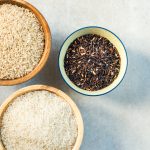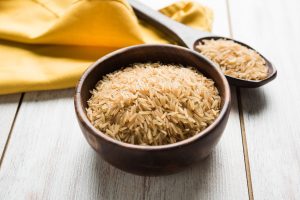Rice is a staple food enjoyed by millions around the world, but with so many varieties available, choosing the right type for your meals can be overwhelming. In this article, we’ll focus on three popular varieties—brown rice, basmati rice, and black wild rice—offering insights into their unique characteristics, culinary uses, health benefits, and tips on how to make the best choice for your dishes.
Brown Rice: Rich in Nutrients and Fiber
What Is Brown Rice?
Brown rice is a whole grain rice that has been minimally processed. Unlike white rice, which has had its husk, bran, and germ removed, brown rice retains its outer layers. This makes it richer in nutrients and fiber. The nutty flavor and chewy texture of brown rice make it a popular choice for those seeking a wholesome, hearty grain.
Nutritional Benefits
- High in Fiber: The bran layer in brown rice is packed with dietary fiber, which helps with digestion and can contribute to lower cholesterol levels.
- Rich in Vitamins and Minerals: Brown rice contains essential nutrients such as B vitamins (especially B6), magnesium, phosphorus, and selenium. These nutrients support various bodily functions, from energy metabolism to immune health.
- Low Glycemic Index: Brown rice has a lower glycemic index compared to white rice, which means it causes a slower, more gradual increase in blood sugar levels. This can be beneficial for managing diabetes or maintaining stable energy levels.
Cooking Brown Rice
Cooking brown rice takes a bit more time than white rice due to its unprocessed nature. Here’s a simple method:
- Rinse: Rinse the brown rice under cold water to remove excess starch.
- Boil: Combine 1 cup of brown rice with 2.5 cups of water in a pot. Bring to a boil.
- Simmer: Reduce the heat to low, cover the pot, and simmer for 45-50 minutes, or until the rice is tender and the water is absorbed.
- Rest: Let the rice sit for 10 minutes off the heat before fluffing with a fork.
Culinary Uses
Brown rice’s hearty texture and nutty flavor make it an excellent choice for a variety of dishes:
- Stir-Fries: Its chewy texture complements stir-fried vegetables and meats.
- Salads: Brown rice adds a nutritious boost to grain salads.
- Soups: It can be used in soups and stews to add substance and depth.
Basmati Rice: The Fragrant and Aromatic Variety
What Is Basmati Rice?
Basmati rice is a long-grain variety known for its distinct aroma and delicate flavor. Originating from the Indian subcontinent, it is often used in South Asian cuisine. The grains are slender and have a non-sticky texture when cooked, making basmati rice ideal for dishes where the rice needs to remain separate.
Nutritional Benefits
- Aromatic Compounds: Basmati rice contains natural aromatic compounds such as 2-acetyl-1-pyrroline, which gives it its characteristic fragrance.
- Lower Glycemic Index: Similar to brown rice, basmati rice also has a lower glycemic index compared to white rice. This can help in managing blood sugar levels.
- Low in Fat: Basmati rice is low in fat and calories, which makes it a good option for those watching their weight or looking for a lighter meal.
Cooking Basmati Rice
To achieve perfectly fluffy basmati rice, follow these steps:
- Rinse and Soak: Rinse the rice under cold water until the water runs clear. Soak the rice in water for at least 30 minutes, then drain.
- Boil: Combine 1 cup of soaked basmati rice with 1.5 cups of water in a pot. Bring to a boil.
- Simmer: Reduce the heat to low, cover, and simmer for 15-20 minutes, or until the rice is tender and the water is absorbed.
- Fluff: Let the rice sit for 5 minutes off the heat before fluffing with a fork.
Culinary Uses
Basmati rice’s fragrant aroma and light, fluffy texture make it perfect for:
- Pilafs and Biryanis: It pairs wonderfully with spiced meats and vegetables in pilafs and biryanis.
- Curries: Its delicate flavor complements rich and spicy curries.
- Side Dishes: Serve it as a side dish with grilled meats or vegetables.
Black Wild Rice: The Unique and Nutritious Option
What Is Black Wild Rice?
Despite its name, black wild rice is not a true rice but rather a semi-aquatic grass. It is known for its dark color, nutty flavor, and chewy texture. Black wild rice is often used for its striking appearance and distinctive taste.
Nutritional Benefits
- Rich in Antioxidants: Black wild rice is high in anthocyanins, which are powerful antioxidants that help protect cells from damage and reduce inflammation.
- High in Protein: It contains more protein compared to white rice and is a good source of essential amino acids.
- Mineral-Rich: Black wild rice is rich in minerals such as iron, zinc, and magnesium, which support overall health.
Cooking Black Wild Rice
Cooking black wild rice requires a bit of patience, but the result is worth it:
- Rinse: Rinse the black wild rice under cold water.
- Boil: Combine 1 cup of black wild rice with 3 cups of water in a pot. Bring to a boil.
- Simmer: Reduce the heat to low, cover, and simmer for 45-60 minutes, or until the rice is tender and the grains have burst open.
- Rest: Allow the rice to sit for 10 minutes off the heat before fluffing with a fork.
Culinary Uses
Black wild rice’s bold flavor and color make it a versatile ingredient for:
- Salads: It adds a unique texture and color to salads.
- Stuffings: Use it in stuffings for vegetables or poultry.
- Side Dishes: Serve it alongside roasted meats or as a base for grain bowls.
Making the Right Choice: Factors to Consider
When choosing between brown rice, basmati rice, and black wild rice, consider the following factors:
Flavor and Texture Preferences
- Brown Rice: Ideal for a hearty, nutty flavor and chewy texture.
- Basmati Rice: Perfect for a light, aromatic, and fluffy texture.
- Black Wild Rice: Offers a unique, nutty flavor and chewy texture with a striking appearance.
Nutritional Goals
- Brown Rice: Great for higher fiber content and overall nutrition.
- Basmati Rice: Suitable for lower fat and calorie content while still providing essential nutrients.
- Black Wild Rice: Excellent for high antioxidant content and additional protein.
Cooking Time and Ease
- Brown Rice: Takes the longest to cook but is worth the time for its health benefits.
- Basmati Rice: Quick and easy to prepare, making it a convenient choice for everyday meals.
- Black Wild Rice: Requires a longer cooking time but adds a distinctive element to dishes.
Conclusion
Choosing the right rice for your meals depends on your personal taste preferences, nutritional needs, and the type of dish you’re preparing. Brown rice offers a nutritious, chewy option; basmati rice provides a fragrant, fluffy texture; and black wild rice adds a unique flavor and striking color. By understanding the characteristics and benefits of each type, you can make informed decisions and enhance your culinary experiences. Enjoy experimenting with these varieties to find the perfect match for your next meal!



